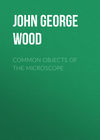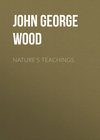Czytaj książkę: «Bible Animals», strona 37
THE CRANE
Various passages in which the Crane is mentioned—Its migratory habits, and loud voice—Geographical range of the Crane—The bird once plentiful in the fen districts of England—Its favourite roosting-places—Size of the Crane, and measurement of the wings—The Crane once used as food—Plumes of the Crane and their use—Structure of the vocal organs—Nest and eggs of the Crane.
In the description of the dove and the swallow two passages have been quoted in which the name of the Crane is mentioned, one referring to its voice, and the other to its migratory instinct. The first passage occurs in Isa. xxxviii. 14: "Like a crane or swallow, so did I chatter;" and the other in Jer. viii. 7: "The turtle and the crane and the swallow observe the time of their coming."
It is rather remarkable that in both these cases the word "Crane" is used in connexion with the swallow, or rather the swift, and that in both instances the names of the birds should have been interchanged. If we refer to the original of these passages, we shall find that the former of them would run thus, "Like a sis or an agur" and the latter thus, "The turtle and the sis and the agur." That in these passages the interpretation of the words sis and agur have been interchanged has already been mentioned, and, as the former has been described under the name of swallow or swift, we shall now treat of the latter under the title of Crane.

THE CRANE.
"Like a crane … so did I chatter."—Isa. xxxviii. 14.
The species here mentioned is the common Crane (Grus cinerea), a bird which has a very wide range, and has occasionally made its appearance in one or two parts of Great Britain. In Ireland it is thought to be common, but in that country the word Crane is simply a popular misnomer for the heron. As is the case with many wild birds, especially those of the larger kinds, the Crane appears to have been a much more frequent visitor of our shores than can be the case in the present day, when the land is thickly populated, and not a strange bird can show itself without running the risk of being shot.
As might be imagined, the Cranes favoured the great fen-districts of England, especially those of Cambridgeshire and Lincolnshire, where it used to be found in large flocks. That in those days it bred in England is evident from Acts of Parliament in the reigns of Henry VIII. and Edward VI., in which reigns the taking of a Crane's egg was punished with a fine of twenty pence, in those days a considerable sum, being nearly four times the average daily wages of a working man. A small flock of Cranes was seen in Zetland in 1807, but at the present time drainage, cultivation, and house-building have as effectually extirpated the gregarious Crane as the solitary bittern.
The Crane performs its annual migrations in company, vast flocks of many thousand individuals passing like great clouds at an immense height, whence their trumpet-like cry is audible for a great distance round, and attracts the ear if not the eye to them. Thus we have at a glance both the characteristics to which reference is made in the Scriptures, namely, the noisy cry and the habit of migration.
It is a very gregarious bird, associating with its comrades in flocks, just as do the starlings and rooks of our own country, and, like these birds, has favourite roosting-places in which it passes the night. When evening approaches, the Cranes may be seen in large flocks passing to their roosting-places, and, on account of their great size, having a very strange effect. A fair-sized Crane will measure seven feet across the expanded wings, so that even a solitary bird has a very imposing effect when flying, while that of a large flock of Cranes on the wing is simply magnificent.
The spots which the Crane selects for its roosting-places are generally of the same character. Being in some respects a wary bird, though it is curiously indifferent in others, it will not roost in any place near bushes, rocks, or other spots which might serve to conceal an enemy. The locality most favoured by the Crane is a large, smooth, sloping bank, far from any spot wherein an enemy may be concealed. The birds keep a careful watch during the night, and it is impossible for any foe to approach them without being discovered. The Crane is noisy on the wing, and, whether it be soaring high over head on its long migratory journeys, or be merely flying at dusk to its roosting-place, it continually utters its loud, clangorous cry.
The food of the Crane is much like that of the heron, but in addition to the frogs, fish, worms, and insects, it eats vegetable substances. Sometimes it is apt to get into cultivated grounds, and then does much damage to the crops, pecking up the ground with its long beak, partly for the sake of the worms, grubs, and other creatures, and partly for the sake of the sprouting seeds.
Although by reason of its scarcity the Crane has been abandoned as food, its flesh is really excellent, and in former days was valued very highly, and was looked upon much in the same light as grouse or blackcock by ourselves at the present day. The two facts, that it was once comparatively plentiful and that it was highly valued for the table, are shown by an old record of the banquet following the enthronization of an Archbishop of Canterbury, at which two hundred and four Cranes were served at table. Even in those days the bird was a very valuable one, the average cost exceeding three shillings, so that none but the wealthy could indulge in such a luxury.
Like the egret, the Crane is remarkable for the flowing plumes of the back, which fall over the tail feathers, and form a train. These feathers are much used as plumes, both for purposes of dress and as brushes or flappers wherewith to drive off the flies. By reason of this conformation, some systematic zoologists have thought that it has some affinity to the ostrich, the rhœa, and similar birds, and that the resemblance is strengthened by the structure of the digestive organs, which are suited to vegetable as well as animal substances, the stomach being strong and muscular.
The peculiar voice of the Crane, which it is so fond of using, and to which reference is made in the Scriptures, is caused by a peculiar structure of the windpipe, which is exceedingly long, and, instead of going straight to the lungs, undergoes several convolutions about the breast-bone, and then proceeds to the lungs.
The Crane makes its nest on low ground, generally among osiers or reeds, and it lays only two eggs, pale olive in colour, dashed profusely with black and brown streaks.
THE STORK
Signification of the Hebrew word Chasidah—Various passages in which it is mentioned—The Chasidah therefore a large, wide-winged, migratory bird—Its identification with the Stork—Derivation of its Hebrew name—The Stork always protected—Uses of the tail—Its mode of quartering the ground in search of food—Migratory habits of the Stork—Nesting of the bird, and its favourite localities—The fir-trees of Palestine—Love of the Stork for its young.
In the Old Testament there are several passages wherein is mentioned the word Chasidah. We will take these passages in their order. In the first place, we find that the Chasidah is enumerated in Lev. xi. 19 among the unclean creatures: "And the stork, the heron after her kind, and the lapwing, and the bat." The parallel passage in Deut. xiv. 18 has precisely the same words. Next we have the passage in Job xxxix. 13: "Gavest thou the goodly wings unto the peacocks? or the feathers of the chasidah and ostrich?" (marginal reading.) Next we come to Ps. civ. 16, 17: "The trees of the Lord are full of sap; the cedars of Lebanon, which He hath planted.
"Where the birds make their nests: as for the chasidah, the fir-trees are her house."
Passing to the prophets, we find that Jeremiah uses the same word (viii. 7): "Yea, the chasidah in the heaven knoweth her appointed times; and the turtle and the crane and the swallow observe the time of their coming; but my people know not the judgment of the Lord."
The last mention of the word occurs in Zech. v. 9: "Then lifted I up mine eyes, and looked, and, behold, there came out two women, and the wind was in their wings; (for they had wings like the wings of a chasidah;) and they lifted up the ephah between the earth and the heaven."
We learn from these passages that, in the first place, the Chasidah was certainly a bird, as it is mentioned in connexion with other birds, and is said to have wings and feathers. Our next business is to find out what particular bird is meant by the Chasidah. It is evident from the passage in Jeremiah that it is a migratory bird; from that in the Psalms, that it builds its nest upon a fir-tree; and from those in Job and Zechariah, that it is a large-winged bird. These details very much narrow the question, which is still further limited by the fact that we have already identified the crane and the heron.
The Authorized Version invariably renders the word Chasidah as "Stork," and is undoubtedly right; though the Septuagint has no less than four different translations, reading it as "heron" in one place, "pelican" in another, "hoopoe" in another, and in the fourth instance leaving the word untranslated, but Græcized into the form of asida. It would have been better if the last-mentioned plan had been followed throughout.
There is, however, no doubt that the Authorized Version is perfectly correct; and it is followed by the Jewish Bible, in which no mark of doubt is affixed to the word.
In Buxtorf's Lexicon there is a curious derivation of the word. He says that the word Chasidah is derived from chesed, a word that signifies benevolence. This word is used in many familiar passages; such as, "unworthy of all the benefits," "according to the multitude of Thy mercies," "exercising pity," and so forth.
According to some writers, the name was given to the Stork because it was supposed to be a bird remarkable for its filial piety; "for the storks in their turn support their parents in their old age: they allow them to rest their necks on their bodies during migration, and, if the elders are tired, the young ones take them on their backs." According to others, the name is given to the Stork because it exercises kindness towards its companions in bringing them food; but in all cases the derivation of the word is acknowledged to be the same.
Partly in consequence of this idea, which is a very old and almost universal one, and partly on account of the great services rendered by the bird in clearing the ground of snakes, insects, and garbage, the Stork has always been protected through the East, as it is to the present day in several parts of Europe. The slaughter of a Stork, or even the destruction of its eggs, would be punished with a heavy fine; and in consequence of the immunity which it enjoys, it loves to haunt the habitations of mankind.
In many of the Continental towns, where sanitary regulations are not enforced, the Stork serves the purpose of a scavenger, and may be seen walking about the market-place, waiting for the offal of fish, fowls, and the like, which are simply thrown on the ground for the Storks to eat. In Eastern lands the Stork enjoys similar privileges, and we may infer that the bird was perfectly familiar both to the writers of the various Scriptural books in which it was mentioned, and to the people for whom these books were intended.
When they settle upon a tract of ground, the Storks divide it among themselves in a manner that seems to have a sort of system in it, spreading themselves over it with wonderful regularity, each bird appearing to take possession of a definite amount of ground. By this mode of proceeding, the ground is rapidly cleared of all vermin; the Storks examining their allotted space with the keenest scrutiny, and devouring every reptile, mouse, worm, grub, or insect that they can find on it. Sometimes they will spread themselves in this manner over a vast extent of country, arriving suddenly, remaining for several months, and departing without giving any sign of their intention to move.
The wings of the Stork, which are mentioned in Holy Writ, are very conspicuous, and are well calculated to strike an imaginative mind. The general colour of the bird is white, while the quill feathers of the wings are black; so that the effect of the spread wings is very striking, an adult bird measuring about seven feet across, when flying. As the body, large though it may be, is comparatively light when compared with the extent of wing, the flight is both lofty and sustained, the bird flying a very great height, and, when migrating, is literally the "stork in the heavens."
Next we come to the migratory habits of the Stork.
Like the swallow, the Stork resorts year after year to the same spots; and when it has once fixed on a locality for its nest, that place will be assuredly taken as regularly as the breeding-season comes round. The same pair are sure to return to their well-known home, notwithstanding the vast distances over which they pass, and the many lands in which they sojourn. Should one of the pair die, the other finds a mate in a very short time, and thus the same home is kept up by successive generations of Storks, much as among men one ancestral mansion is inhabited by a series of members of the same family.
So well is this known, that when a pair of Storks have made their nest in a human habitation their return is always expected, and when they arrive the absentees are welcomed on all sides. In many countries breeding-places are specially provided for the Storks; and when one of them is occupied for the first time, the owner of the house looks upon it as a fortunate omen.
The localities chosen by the Stork for its nest vary according to the surrounding conditions. The foundation which a Stork requires is a firm platform, the more elevated the better, but the bird seems to care little whether this platform be on rocks, buildings, or trees. If, for example, it builds its nest in craggy places, far from the habitations of man, it selects some flat ledge for the purpose, preferring those that are at the extreme tops of the rocks. The summit of a natural pinnacle is a favourite spot with the Stork.
In many cases the Stork breeds among old ruins, and under such circumstances it is fond of building its nest on the tops of pillars or towers, the summits of arches, and similar localities. When it takes up its abode among mankind, it generally selects the breeding-places which have been built for it by those who know its taste, but it frequently chooses the top of a chimney, or some such locality.
Sometimes, however, it is obliged to build in spots where it can find neither rocks nor buildings, and in such cases it builds on trees, and, like the heron, is sociable in its nesting, a whole community residing in a clump of trees. It is not very particular about the kind of tree, provided that it be tolerably tall, and strong enough to bear the weight of its enormous nest; and the reader will at once see that the fir-trees are peculiarly fitted to be the houses for the Stork.
As is the case with so many zoological words, botanical names seem to be frequently used in a collective sense by the scriptural writers, several species being signified by a single name. Thus the word which is in some cases translated as "fir," is in some rendered as "pine-tree," in others as "juniper," and in others as "cypress." In the present case it is undoubtedly translated rightly, though in the Jewish Bible it is rendered as "cypress:" "The trees of the Eternal satisfy themselves, the cedars of Lebanon which He hath planted; where birds make their nests: as for the stork, cypresses are its house."

THE STORK.
"As for the stork, the fir-trees are her house."—Ps. civ. 17.
The particular species of fir-tree to which the Psalmist alludes is probably the Aleppo pine (Pinus halepensis), which comes next to the great cedars of Lebanon in point of size. It was this tree that furnished the timber and planks for Solomon's temple and palace, a timber which was evidently held in the greatest estimation. This tree fulfils all the conditions which a Stork would require in nest-building. It is lofty, and its boughs are sufficiently horizontal to form a platform for the nest, and strong enough to sustain it. On account of its value, and the reckless manner in which it has been cut down without new plantations being formed, the Aleppo pine has vanished from many parts of Palestine wherein it was formerly common, and would afford a dwelling-place for the Stork.
There are, however, several other species of fir which are common in various parts of the country, each species flourishing in the soil best suited to it, so that the Stork would never be at a loss to find a nesting-place in a country which furnished so many trees suitable to its purposes.
As may be expected from the localities chosen by the Stork for its breeding-place, its nest is very large and heavy. It is constructed with very little skill, and is scarcely more than a huge quantity of sticks, reeds, and similar substances, heaped together, and having in the middle a slight depression in which the eggs are laid. These eggs are usually three, or perhaps four in number, and now and then a fifth is seen, and are of a very pale buff or cream colour.
As is the case with the heron, the young of the Stork are quite helpless when hatched, and are most ungainly little beings, with their long legs doubled under them, unable to sustain their round and almost naked bodies, while their large beaks are ever gaping for food. Those of my readers who have had young birds of any kind must have noticed the extremely grotesque appearance which they possess when they hold up their heads and cry for food, with their bills open to an almost incredible extent. In such birds as the Stork, the heron, and others of the tribe, the grotesque appearance is exaggerated in proportion to the length and gape of the bill.
The Stork is noted for being a peculiarly kind and loving parent to its young, in that point fully deserving the derivation of its Hebrew name, though its love manifests itself towards the young, and not towards the parent.
The Rev. H. B. Tristram mentions from personal experience an instance of the watchful care exercised by the Stork over its young. "The writer was once in camp near an old ruined tower in the plains of Zana, south of the Atlas, where a pair of storks had their nest. The four young might often be seen from a little distance, surveying the prospect from their lonely height, but whenever any of the human party happened to stroll near the tower, one of the old storks, invisible before, would instantly appear, and, lighting on the nest, put its feet gently on the necks of all the young, so as to hold them down out of sight till the stranger had passed, snapping its bill meanwhile, and assuming a grotesque air of indifference, as unconscious of there being anything under its charge." (Smith's "Dict. Bible," vol. iii. p. 1384.)
The snapping noise which is here mentioned is the only sound produced by the Stork, which is an absolutely silent bird, as far as voice is concerned.
There is another species of Stork found in Palestine, to which the fir-trees are especially a home. This is the Black Stork (Ciconia nigra), which in some parts of the country is even more plentiful than its white relative, which it resembles in almost every particular, except that it has a dark head and back, the feathers being glossed with purple and green like those of the magpie. This species, which is undoubtedly included in the Hebrew word chasidah, always makes its nest on trees whenever it can find them, and in some of the more densely wooded parts of Palestine is in consequence plentiful, placing its nest in the deepest parts of the forests. When it cannot obtain trees, it will build its nest on rocky ledges. It lays two or three eggs of a greenish white colour.
Like the preceding species, the Black Stork is easily domesticated. Colonel Montague kept one which was very tame, and would follow its keeper like a dog. Its tameness enabled its proceedings to be closely watched, and its mode of feeding was thereby investigated. It was fond of examining the rank grass and mud for food, and while doing so always kept its bill a little open, so as to pounce down at once on any insect or reptile that it might disturb.
Eels were its favourite food, and it was such an adept at catching them that it was never seen to miss one, no matter how small or quick it might be. As soon as it had caught one of these active fish, it went to some dry place, and then disabled its prey by shaking and beating it against the ground before swallowing it, whereas many birds that feed on fish swallow their prey as soon as it is caught. The Stork was never seen to swim as the heron sometimes does, but it would wade as long as it could place its feet on the bed of the stream, and would strain its head and the whole of its neck under water in searching for fish.
It was of a mild and peaceable disposition, and, even if angered, did not attempt to bite or strike with its beak, but only denoted its displeasure by blowing the air sharply from its lungs, and nodding its head repeatedly. After the manner of Storks, it always chose an elevated spot on which to repose, and took its rest standing on one leg, with its head so sunk among the feathers of its shoulders that scarcely any part of it was visible, the hinder part of the head resting on the back, and the bill lying on the fore-part of the neck.
Though the bird is so capable of domestication, it does not of its own accord haunt the dwellings of men, like the White Stork, but avoids the neighbourhood of houses, and lives in the most retired places it can find. It may generally be seen in marshy grounds, spending the greater part of its time in procuring food, or in going to and from its nest while engaged in the task of feeding its young.















